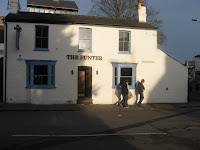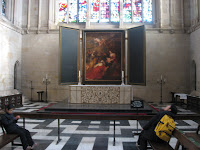









 On this warm sunny Saturday our destination was Cambridge. As you can see by Alexander's expression the kids were 'thrilled' to be spending Saturday in Cambridge. To get them to go peacefully we had to promise that next weekend they could vegetate at home, doing absolutely nothing that could be construed as educational or of a physical nature such as walking. Another first for me - a ride in a double-decker bus. All around the city outskirts there are Park and Ride locations, where for £2 each, children are free, we were transported into the city centre on modern double-decker buses. My only experience with English bus travel was watching an old BBC TV program called On the Buses. Our first stop was King's College, one of King Henry the Sixth's two royal and religious foundations; the other being Eton College. King Henry VI laid the foundation stone for King's College on Passion Sunday 1441. Prior to our visit I researched Cambridge on the Internet and found one website that suggested, to tour areas of the Colleges closed to the public one should carry text books and have the air of a scholar - or produce a counterfeit students pass. We ignored these suggestions and were forced to keep to the paths designated for tourists. I have seen many chapels in the Cathedrals of England and attended many services in the Lady Chapel of St George's Cathedral in Kingston, Ontario, so I was unprepared for the size and grandeur of King's College Chapel. The absence of transepts and side chapels just enhanced the length and height of the interior. We were allowed to take photographs, but without a flash as it may set off alarms, so what photos I took lacked detail. The chapel is bisected by a large dark oak Screen that houses the organ. The screen was a gift from Henry VIII and bears the initials of both Henry VIII and those of his Queen, Anne Boleyn. This dates it between his marriage to Anne in 1533 and her execution in 1536. History before our eyes. The altar stood in front of ' the Adoration of the Magi', painted by Ruebans in 1634. This was gifted to the Chapel in 1961. Our next stop was St John's College. unfortunately we were restricted to the Chapel, Chapel Court, First Court and Second Court and again photos were allowed but without flashes. St John's College was refounded by Lady Margaret Beaufort in 1511. Previously it had been the Hospital of St John, a monastic order founded in the early part of the thirteenth century. From there we went back in time to a round church built in about 1130 by the 'fraternity of the Holy Sepulchre'. It is one of only four round churches built following the crusade of 1097. The construction of all four was influenced by the Church of the Holy Sepulchre in Jerusalem built by the Emperor Constantine in the 4th century. Initially it served as a wayfarers' chapel situated on the main road through Cambridge. In the 13th century it became a normal parish church with the addition of a chancel and north aisle. There were bikes everywhere! The one thing that does not show up in the photo of bikes leaning against a wall is the sign reading 'Please do not lean bikes against this wall' - students!!
On this warm sunny Saturday our destination was Cambridge. As you can see by Alexander's expression the kids were 'thrilled' to be spending Saturday in Cambridge. To get them to go peacefully we had to promise that next weekend they could vegetate at home, doing absolutely nothing that could be construed as educational or of a physical nature such as walking. Another first for me - a ride in a double-decker bus. All around the city outskirts there are Park and Ride locations, where for £2 each, children are free, we were transported into the city centre on modern double-decker buses. My only experience with English bus travel was watching an old BBC TV program called On the Buses. Our first stop was King's College, one of King Henry the Sixth's two royal and religious foundations; the other being Eton College. King Henry VI laid the foundation stone for King's College on Passion Sunday 1441. Prior to our visit I researched Cambridge on the Internet and found one website that suggested, to tour areas of the Colleges closed to the public one should carry text books and have the air of a scholar - or produce a counterfeit students pass. We ignored these suggestions and were forced to keep to the paths designated for tourists. I have seen many chapels in the Cathedrals of England and attended many services in the Lady Chapel of St George's Cathedral in Kingston, Ontario, so I was unprepared for the size and grandeur of King's College Chapel. The absence of transepts and side chapels just enhanced the length and height of the interior. We were allowed to take photographs, but without a flash as it may set off alarms, so what photos I took lacked detail. The chapel is bisected by a large dark oak Screen that houses the organ. The screen was a gift from Henry VIII and bears the initials of both Henry VIII and those of his Queen, Anne Boleyn. This dates it between his marriage to Anne in 1533 and her execution in 1536. History before our eyes. The altar stood in front of ' the Adoration of the Magi', painted by Ruebans in 1634. This was gifted to the Chapel in 1961. Our next stop was St John's College. unfortunately we were restricted to the Chapel, Chapel Court, First Court and Second Court and again photos were allowed but without flashes. St John's College was refounded by Lady Margaret Beaufort in 1511. Previously it had been the Hospital of St John, a monastic order founded in the early part of the thirteenth century. From there we went back in time to a round church built in about 1130 by the 'fraternity of the Holy Sepulchre'. It is one of only four round churches built following the crusade of 1097. The construction of all four was influenced by the Church of the Holy Sepulchre in Jerusalem built by the Emperor Constantine in the 4th century. Initially it served as a wayfarers' chapel situated on the main road through Cambridge. In the 13th century it became a normal parish church with the addition of a chancel and north aisle. There were bikes everywhere! The one thing that does not show up in the photo of bikes leaning against a wall is the sign reading 'Please do not lean bikes against this wall' - students!!No visit is complete without a trip to a pub, but it was difficult to find a pub that had a table for four and allowed persons under 18. We set out with map in hand and crossed over the river Cam with its punters out and about and found the punter where we had some of the best french fries - I mean chips - yet and I had pint of Woodforde's Wherry; another fine example of a cask ale.
We made our way back to the bus stop for our green Park and Ride bus (they are colour coded, a great idea for someone like myself who has trouble remembering where I put my hat). On the way I snapped the photo of the building leaning out into the street. It seemed out of place with all the beautiful architecture of the colleges and churches, but I imagine this is an example of what many of the shops must have looked like in a bygone era.
Another wonderful day discovering England.








































